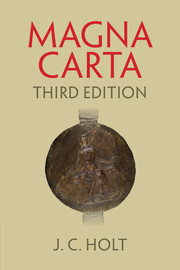Book contents
- Frontmatter
- Dedication
- Contents
- List of plates
- Preface to third edition
- Preface to second edition
- Preface to first edition
- Acknowledgements
- Abbreviations
- Introduction
- 1 The Charter and its history
- 2 Government and society in the twelfth century
- 3 Privilege and liberties
- 4 Custom and law
- 5 Justice and jurisdiction
- 6 Crisis and civil war
- 7 Quasi Pax
- 8 The quality of the Great Charter
- 9 The achievement of 1215
- 10 From distraint to war
- 11 The re-issues and the beginning of the myth
- Appendices
- 1 The meeting at Bury St Edmunds, 1214
- 2 Notification of Thomas count of Perche, February 1215
- 3 Triplex forma pacis
- 4 The ‘unknown’ charter
- 5 The Articles of the Barons
- 6 Magna Carta, 1215
- 7 Translations of the Charters
- 8 The Twenty-Five barons of Magna Carta, 1215
- 9 The date of the London treaty
- 10 The Oxford Council, 16–23 July 1215
- 11 Select documents illustrative of the history of Magna Carta, 1215
- 12 Magna Carta, 1225
- 13 Charter of the Forest, 1225
- 14 Liberties and perpetuity
- References
- Index
- Plate section
9 - The date of the London treaty
from Appendices
Published online by Cambridge University Press: 05 July 2015
- Frontmatter
- Dedication
- Contents
- List of plates
- Preface to third edition
- Preface to second edition
- Preface to first edition
- Acknowledgements
- Abbreviations
- Introduction
- 1 The Charter and its history
- 2 Government and society in the twelfth century
- 3 Privilege and liberties
- 4 Custom and law
- 5 Justice and jurisdiction
- 6 Crisis and civil war
- 7 Quasi Pax
- 8 The quality of the Great Charter
- 9 The achievement of 1215
- 10 From distraint to war
- 11 The re-issues and the beginning of the myth
- Appendices
- 1 The meeting at Bury St Edmunds, 1214
- 2 Notification of Thomas count of Perche, February 1215
- 3 Triplex forma pacis
- 4 The ‘unknown’ charter
- 5 The Articles of the Barons
- 6 Magna Carta, 1215
- 7 Translations of the Charters
- 8 The Twenty-Five barons of Magna Carta, 1215
- 9 The date of the London treaty
- 10 The Oxford Council, 16–23 July 1215
- 11 Select documents illustrative of the history of Magna Carta, 1215
- 12 Magna Carta, 1225
- 13 Charter of the Forest, 1225
- 14 Liberties and perpetuity
- References
- Index
- Plate section
Summary
The case for including the treaty concerning London in the final peace agreed at Runnymede on 19 June is simple and straightforward. It depends on three arguments fully developed above. These are:
a. the strong probability that the firm peace would necessarily include some agreement about London;
b. the clear reference in the treaty to the execution of certain provisions of the Charter;
c. the fact that royal letters of 23 July relating to the ‘peace agreement’ refer to the restoration of castles, which can only come, among surviving documents, from the London treaty.
To these Galbraith has added a fourth argument viz.
d. The improbability that King John would accept an agreement with someone entitled ‘Marshal of the Army of God and Holy Church’ once peace had been restored.
In 1944 Richardson argued that the treaty should be dated to the third week in July. The ground for this is that the treaty is entered on the dorse of the membrane of the Close roll which covered the period 11–19 July. Cheney also took this view, although more tentatively. This is discussed in appendix 10 below, pp. 409–10.
Cheney also felt that the memorandum attached to the list of the Twenty-Five in Lambeth MS 371 had some bearing on the matter. This includes the proviso that the ‘mayor will hand over the city of London to the barons if the king happens to decide to contravene his charter’. Cheney took this to be part of a sequence of arrangements concerning London, in which case, he considered, the memorandum must antedate the treaty, which must accordingly record a situation subsequent to Runnymede, rendering a date of the third week in July the most likely. But there are difficulties. The treaty is an official record: the list an informal memorandum. They are not on a par or of equal weight; and there is no compelling need to read them sequentially on the presumption that the state of London was determined exclusively by the one or the other.
- Type
- Chapter
- Information
- Magna Carta , pp. 405 - 406Publisher: Cambridge University PressPrint publication year: 2015



